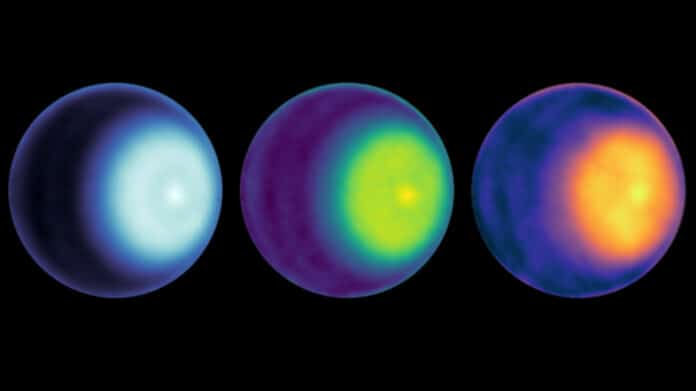Uranus is regarded as a world of mystery. It was seen only once, as NASA’s probe passed near the planet nearly four decades ago. Using huge radio antenna dishes of the Very Large Array in New Mexico, scientists present observations of Uranus in northern spring with the Very Large Array from 0.7 to 5 cm.
For the first time, NASA scientists have convincing evidence that Uranus has polar cyclones. They discovered the phenomenon at the planet’s north pole by looking at radio waves radiated by the ice giant.
Collected in 2015, 2021, and 2022, the observations went deeper into Uranus’ atmosphere than before. These observations reveal details in the thermal emission from Uranus’ north pole at 10s of bar.
The results support a general observation about all planets in our solar system with significant atmospheres: Whether they are mostly made of rock or gas, their atmospheres exhibit signs of a whirling vortex around the poles.
When peered below the planet’s clouds, scientists determined that the circulating air at the north pole seemed to be warmer and drier, indicating a strong cyclone.
Lead author Alex Akins of NASA’s Jet Propulsion Laboratory in Southern California said, “These observations tell us a lot more about the story of Uranus. It’s a much more dynamic world than you might think. It isn’t just a plain blue ball of gas. A lot is happening under the hood.”
The compactly structured cyclone on Uranus, which has warmed up, dry air at its center, resembles those observed by NASA’s Cassini at Saturn. But unlike hurricanes on Earth, cyclones on Uranus and Saturn aren’t formed over water. They also don’t drift and are locked at the poles.
In the upcoming years, these recently discovered researchers will constantly monitor the Uranus cyclone to see how it develops.
Akins said, “Does the warm core we observed represent the same high-speed circulation seen by Voyager? Or are there stacked cyclones in Uranus’ atmosphere? The fact that we’re still finding out such simple things about how Uranus’ atmosphere works excites me to learn more about this mysterious planet.”
Journal Reference:
- Alex Akins, Mark Hofstadter, et al. Evidence of a Polar Cyclone on Uranus From VLA Observations. Geophysical Research Letters. DOI: 10.1029/2023GL102872
